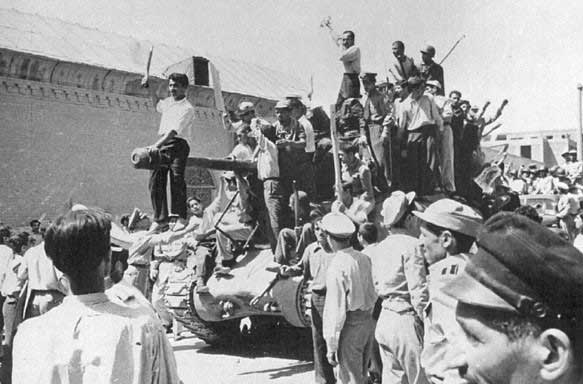
Think of a time when you said to yourself, “Ugh! That was a mistake,” or “How could I have done that?” or “I should have thought that through!” We have all made decisions that we came to regret, some small and some, unfortunately, very significant. Studying history provides a way to get more perspective in making decisions!
In addition to long-term and short-term context, history provides examples of decisions made by people in the past. We can learn by their examples. But our study of history is always in hindsight, always postmortem. We know how events turned out as we examine decisions made. The knowledge of outcomes can make it difficult to empathize with historical characters. It can make us a little smug and judgmental. “Well, they certainly made a mistake in that foolish Embargo Act of 1807!”
As I described in my previous blog regarding the Opening of Japan, a decision-making approach to history can engender empathy and humility. Students feel the challenge of making a decision before they know how it turned out. It is foresight history, rather than hindsight history. I outlined the P-A-G-E model for decision making in that blog and focused a bit more on a strategy to help students to ask good questions.
Check out the Decision-making in World History workbook here!
The outlined lesson below highlights a different strategy, where students have to think about consequences through the “premortem.” To wit: What if we asked students to take a few minutes before their final decision to imagine how their decision might look years from that point?
Sample Lesson
This lesson on the United States decision to overthrow Mohammed Mossadegh, the Prime Minister of Iran in 1953, is excerpted from Decision Making in United States History. The complete list of 99 decision-making lessons in U.S. History (plus 41 lessons in world history) is on my website. As we analyze student decisions through P-A-G-E, we will spotlight the strategy of the premortem.
Check out the Decision-making in United States workbook here!
Student Handout 1 (Excerpt)
It is 1953, and you are President Dwight Eisenhower. You just won election in November 1952, largely because you promised to get tough on communism. Two years ago, the Iranian government under the elected leader, Prime Minister Mossadegh, nationalized the Anglo-Iranian Oil Company, a British company that controlled the production and refinement of Iranian oil. The takeover of the company by the Iranian Government infuriated the British, who wanted to invade Iran and take back the oil fields.
The British have a detailed scheme to remove Mossadegh from power. The Shah (Iran’s king and hereditary ruler) has been in a power struggle with Mossadegh for years. The Shah has the constitutional power to dismiss Mossadegh, but has been reluctant to do so because of Mossadegh’s popularity. Mossadegh has the support of the people, but the Shah has the support of the military. The Shah is also strongly anticommunist; Mossadegh, though not a communist himself, has formed a political alliance with the communist Tudeh party. The British claim that Iran is vulnerable to a communist takeover, and that if the Soviet Union backed a takeover by the Tudeh party, Mossadegh wouldn’t be able to prevent it. Iran would become a communist nation.
All of your main advisors, including Secretary of State John Foster Dulles, support the plan to overthrow Mossadegh. They tell you it is necessary: rioting recently broke out in the streets of Tehran (the capital of Iran), and the situation seems very chaotic there. The CIA has worked with the British to plan a coup (overthrow) against Mossadegh, called Operation Ajax, which your advisors support. The plan would involve the following:
- Secret CIA and British agents will turn public opinion in Iran against Mossadegh. Through lies and rumors, they will portray Mossadegh as corrupt, pro-communist, hostile to Islam, and detrimental to the army.
- Agents will hire thugs to attack religious leaders and make it look as if Mossadegh ordered the attacks.
- Agents will bribe military leaders and members of the parliament, and then pay people to stage an anti-government rally. The Shah will then dismiss Mossadegh, and the parliament will support the move. If Mossadegh resists, the army will overthrow him. Public and religious leaders will support the overthrow.
John Foster Dulles claims this plan offers the only way to stop communist expansion into oil-rich Iran.
Will you support Operation Ajax, and overthrow Prime Minister Mossadegh? Explain your decision.

Student Handout 2 – Outcomes (Excerpt)
President Eisenhower approved Operation Ajax. Pro-Shah military forces ultimately arrested Mossadegh: he would spend two years in prison and the rest of his life under house arrest. The Shah returned to Iran and installed a former general, Fazlollah Zahedi, as the new prime minister. Foreign oil companies returned to Iran to once again ensure a steady flow of oil to western countries. However, the new oil arrangement was different. The Anglo-Iranian Oil Company now held 40% of the oil shares (instead of 100%), while five American companies collectively held 40% and other foreign companies held the remaining 20%. Iran now received half of all oil revenues, instead of the less than 20% it used to get. The decision to put the Shah back in power and give control of Iran’s oil back to the oil companies led to numerous unintended consequences:
- The Shah was unpopular, both because of the circumstances in which he came to power and the methods he used to retain that power. He used much of the oil revenue to buy weapons instead of to develop Iran and help the Iranian people. The CIA helped him to establish a secret police force, called SAVAK, to identify dissenters. SAVAK employed brutal methods and might have been responsible for thousands of deaths.
- Mossadegh had been a democratically elected leader who represented the will of a large percentage of the Iranian people. The Shah, by contrast, held power because of foreign intervention, not because Iranians supported him. This led Iranians to harbor a great deal of resentment towards the U.S. and Britain, making Iran more susceptible to the radical, anti-Western views of radical Muslim clerics such as the Ayatollah Ruhollah Khomeini.
- Khomeini and other clerics rallied the Iranian people to their cause with such anti-Western slogans as “Death to the American Shah!” They referred to the U.S. as the “Great Satan,” and many Iranians agreed: the U.S., after all, had overthrown their democratically elected government.
- In 1979, Khomeini and his radical Islamist followers started a revolution and took control of Iran, establishing an anti-Western Islamic republic.
- Later in 1979, after the revolution, a group of Iranian students feared that the U.S. would again overthrow their government and reinstall the Shah. As a result, they took several dozen Americans hostage at the U.S. embassy and held them for 444 days.
- The success of Operation Ajax gave the CIA a more prominent role in foreign policy decisions and set a precedent for CIA-sponsored overthrows of governments. In subsequent years, the CIA attempted to overthrow governments in Guatemala, Cuba, Chile, the Congo, and Vietnam. These attempted coups reinforced the growing view around the world of the U.S. as an imperialist power determined to interfere in foreign nations in order to further its own purposes.

Procedure
Step 1: Distribute Handout 1 and review the problem and any specialized vocabulary. You will note that nationalization is defined in the sentence after it appears. Have students individually write down their decisions regarding Operation Ajax.
Step 2: Pair students up to discuss their choices. Bring the class together to vote on whether they will support Operation Ajax. Record the votes and asks for arguments for and against the overthrow plan.
Step 3: At this point you can implement the Premortem Strategy: Tell students: “Now I want you to imagine it is decades after your decision in 1953 and things have not gone well. I want you to write out a description of Iran and the United States at that point (in the 1970s). Ask the following questions:
- If you supported the overthrow, what might have gone wrong?
- What are some negative unintended consequences?
- If you opposed the overthrow, what negative unintended effects took place from not overthrowing the government?
- How do you think other countries would think of the overthrow?
It could be difficult for some students to think of long-term negative consequences, an activity that requires imaginative thinking. You can help them by offering suggestions such as, “think of how Iranians would think of the overthrow,” etc.
Step 4: After students have written their descriptions of what could have gone wrong, pair them up again to reassess the options in light of the negative consequences they may have generated from the premortem strategy. Bring the class together again to discusses the possible negative consequences then to revote.
Step 5: Distribute the outcomes of the problem (Handout 2, above). Students are always interested in these outcomes, since they want to see how their own decisions turned out.
Step 6: Debrief the activity:
- How did President Eisenhower do in his decision making versus your students?
- How did students do in their decision making?
- Did the premortem help think about possible unintended consequences?
- What would they do differently the next time?
- What in the outcomes, if anything, surprised students?
Analyze the decision making by President Eisenhower according to the various elements of the P-A-G-E model in the box below.

Ask about reliability of sources: Students should consider the reliability of the Dulles brothers. The brothers seemed to drive the policies of the U.S. government. How did they come to believe that an overthrow was necessary? What evidence did they have that the operation would succeed? Were there any dissenters who opposed Operation Ajax?
Goals: Students should be very clear about their goals and consider how well various plans conform to these goals. They should also consider how realistic their goals are. For example, is it realistic to stop nationalism?
Ethics: Is it right to overthrow an elected government?
Predict consequences: The most significant decision-making element in this lesson is the ability to anticipate long-term consequences. It seems unlikely that the U.S. government would have overthrown Mossadegh had it foreseen the long-term consequences.
The premortem strategy should turn up some negative unintended consequences, a habit of thinking that will help them as citizens and in their personal lives. If we can help more students to think of consequences before reacting in anger or before getting into a car with a drunk classmate, we will indeed have made a significant contribution to a better world!
The Strengths of Decision-making Problems
Decision making problems are engaging and often exciting! But they are also worthwhile lessons for your students to learn in terms of historical perspectives and citizenship. As you can see from the events in Iran, events could have taken many turns, but the decisions at critical junctures were what mattered. When students write down their decisions they might be humbled by their classmates’ arguments or by the outcomes of the problem. No one has to tell them – they learn that they can’t always be certain that they are right. Experience is a great teacher! The more students can question their own biases, be exposed to other opinions, and learn about different perspectives, the more likely the are to build empathy and key citizenship skills!
Get a free trial of Active Classroom to try these decision-making in United States history lessons with your students!
Kevin O’Reilly taught history for 39 years, all but four of those years at Hamilton-Wenham Regional High School in Massachusetts, where he also coached basketball. He is the former NCSS Social Studies Teacher of the Year, along with several other awards, and is the author of 31 books on critical thinking and decision making in history. He is a climate activist and enjoys visiting his 2 sons and 5 grandchildren in Maryland and Japan. Fun fact: He and his wife are both left-handed and so are both their sons. You can see his biography and free critical thinking lessons at http://www.criticalthinkinginhistory.com.
